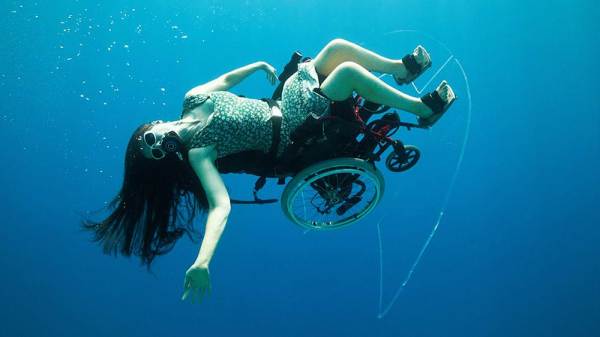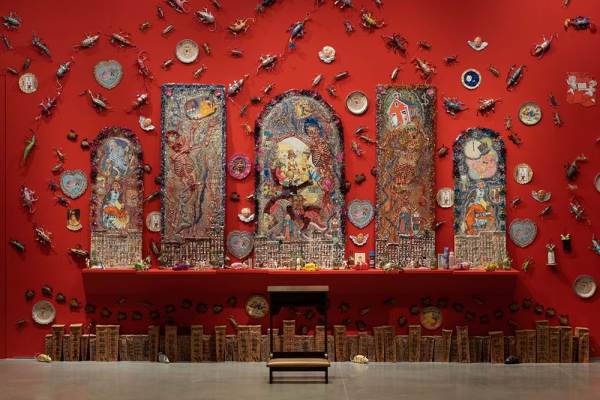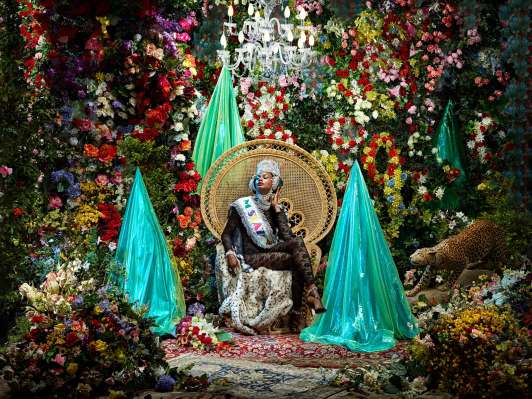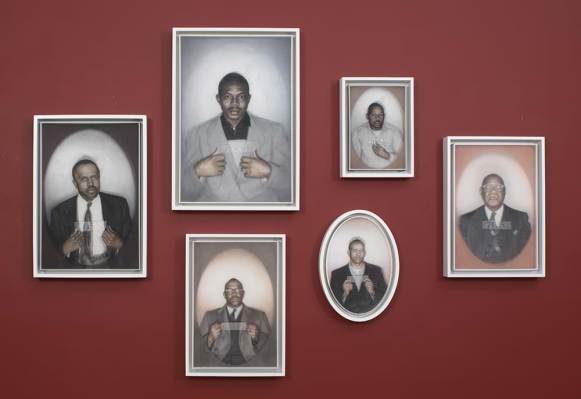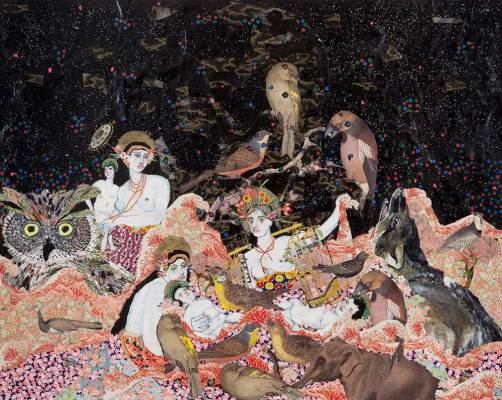Radical Love
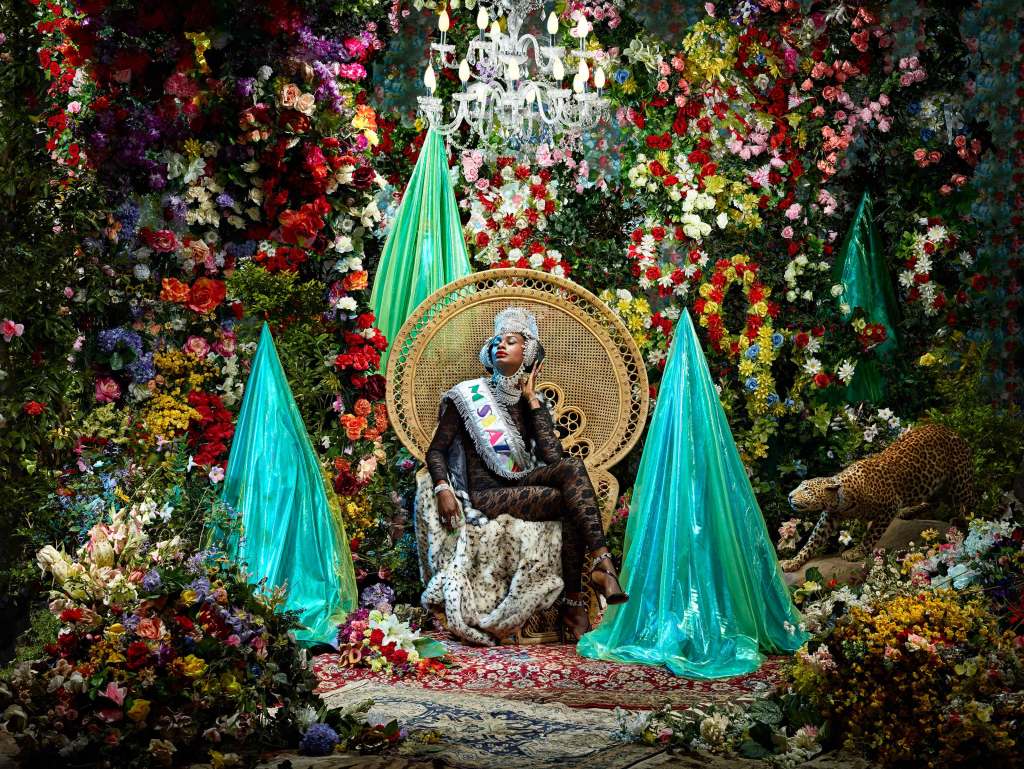
Radical Love is the second of three exhibitions marking the Ford Foundation Gallery’s inaugural year. The trilogy’s theme, UTOPIAN IMAGINATION, is grounded in a call to action by journalist Naomi Klein who argues that propelling socio-political engagement into public policy can be the catalyst for universal human and civil rights. But it requires an all-encompassing “utopian imagination,” a vision unfettered by the current silos into which social justice issues have been carved up and which prevent us from seeking a holistic vision rooted in love of the planet and its inhabitants.
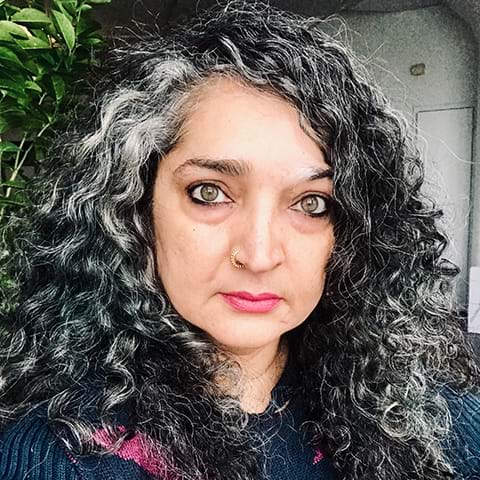
The curatorial premise of UTOPIAN IMAGINATION follows a trajectory toward a more just future. The trilogy launched with the exhibition Perilous Bodies, which looked at violence, racism and inequality. Radical Love offers the solution through works grounded in devotion, abundance and beauty. The final exhibition in the trilogy will offer a way to envision our place in an uncertain future. Given the urgency of these times, whether we look at the global threat of religious extremism or the rise of right-wing leaders impervious to the looming threat of climate change, it is imperative to begin casting an intersectional lens on the struggles we face. In her book “All About Love,” author and activist bell hooks writes:
As a nation, we need to gather our collective courage and face that our society’s lovelessness is a wound. As we allow ourselves to acknowledge the pain of this wound when it pierces our flesh and we feel in the depths of our soul a profound anguish of spirit, we come face to face with the possibility of conversion, of having a change of heart. In this way, recognition of the wound is a blessing because we are able to tend it, to care for the soul in ways that make us ready to receive the love that is promised.”
Understanding the regenerative impact of beauty for those regularly deprived of seeing themselves as such desirable subjects of veneration, Radical Love gathers together representational and highly decorative works offered as an antidote to our collective pain. Mass media often function to maintain oppressive social hierarchies, restricting itself to depictions of the vulnerable among us as victims of sex and gender bias assaults. These depictions bind us to an economy of austerity while failing to understand why we still seek joy and abundance in the face of such darkness.
Even in the most impoverished of communities, beauty is created for public consumption. We see it in the form of celebrations such as carnivals where the line between sculpture and costume is blurred, where everyday people come together to make music and art. For many, a deeply rooted love of their own marginalized community is their driving force. They include iconic black, feminist and LGBTQIA+ artists such as Faith Ringgold and her soft sculptures depicting everyday black folks, as well as artists like Thomas Lanigan-Schmidt and his entire oeuvre of gay iconography intermingled with Catholic motifs. The international artists in Radical Love actively resist making work based in historically sanctioned abstraction or solely informed by the theories of academics to whom we are invisible except as subjects of racist scrutiny.
Employing everything in their arsenal to create enchanting works that turn disabled, black, brown, indigenous and LGBTQIA+ subjects into protagonists of mythical narratives of love and redemption, artists like Ebony Patterson, Raúl de Nieves, Rashaad Newsome and Lina Iris Viktor follow earlier generations to create a pantheon of imagery steeped in devotion, adornment, metaphors and visual patois that reflect the richness of their lived experiences. Viktor, along with La Vaughn Belle, Jeannette Ehlers, Omar Victor Diop, Jackie Tarry and Brad McCallum, turn to global histories of social revolt, often employing their own bodies as stand-ins for legendary figures, canonizing themselves in the process. There is no mistake that it is an act of “radical love” to cast oneself as the subject of art in a world that deems your very existence unworthy.
The art in Radical Love is visceral and emotional, speaking simultaneously to love, joy, pain, grace and glory. Artworks exude a luminosity and lushness, enshrining bodies within nature as in the photographs of Omar Victor Diop and Athi-Patra Ruga, the video of Sue Austin in her underwater wheelchair gliding past reefs with fish as her companions or the glittering installation she saw things she shouldn’t have by Ebony Patterson. We see this, too, in the use of artificial foliage in Lina Puerta’s installation and in the two-dimensional collaged forms in Maria Berrio’s painting Nativity in which women give birth surrounded by animals and foliage against a dreamy landscape. Knowing what we do about our planet’s all-too-possible collapse, these works serve as reminders that we are an intrinsic part of nature and need to focus our efforts on its guardianship for survival.
To take the exploration of Mother Earth and motherhood one step further, an overwhelming number of artists identified motherhood as radical love in their own lives. Raúl De Nieves and Rashaad Newsome identified their mothers as the inspiration behind the bodies of work being exhibited, whether through the qualities they inhabited or as in the last words exchanged between mother and son as featured in Nep Sidhu’s work Confirmation. Rose B. Simpson’s sculptural homage to missing indigenous women considers the impact of their murders on the children who grow up without them. It is as full of pathos as Vanessa German’s weeping Black Madonna holding a boy doll that reminds us of the countless black mothers who have lost their children at the hands of the police. Vocalist Imani Uzuri is in the process of composing an opera on the iconography of the Black Madonna. For Radical Love she composes a soundscape for the atrium garden inspired by the African-American spiritual “Wade In The Water” that will culminate in a participatory performance of her Revolutionary Choir.
Motherhood is a minefield. There is a particular complexity and anxiety attached to the experience of motherhood with the grim outlook for humanity and for the earth. Will our children live through the unimaginable consequences of climate change?
Instead of learning from LGBTQIA+ families about motherhood and parenting unfettered by patriarchal family systems, women’s rights to bodily autonomy is being legislated back into times before Roe v. Wade. In the U.S., maternal deaths are rising–the worst in the developed world. Black women are dying in childbirth at even greater numbers. Those who survive live in fear of their children’s lives being stolen. Newspapers are filled with stories of asylum-seeking families torn asunder at our borders, while more children are killed in this country though gun violence than members of the armed forces in active service. So perhaps it is no surprise that artists in Radical Love express a yearning for systems based in our interconnectedness to nature and one another, where motherhood and the qualities of nurturing–the planet and ourselves–are truly valued. These only begin to unpack the many forms of radical love. Jah Grey’s Dancing in the Light offers an embodiment of the many manifestations of love in this exhibition with its lyrical depictions of embracing black male bodies as a contrast to traditional perceptions of masculinity. The deconstruction of masculinity is taken forward in Jody Paulsen’s large felt installation Find Your Gaggle, within which six Dandies are surrounded by foliage in joyous communion with one another.
Organized religion has failed to satisfy spiritual hunger because it has accommodated secular demands, interpreting spiritual life in ways that uphold the values of a production-centered commodity culture…The basic interdependency of life is ignored so that separateness and individual gain can be deified. Religious fundamentalism is often represented as authentic spiritual practice and given a level of mass media exposure that countercultural religious thought and practice never receive. Usually, fundamentalists, be they Christian, Muslim, or any faith, shape and interpret religious thought to make it conform to and legitimize a conservative status quo. Fundamentalist thinkers use religion to justify supporting imperialism, militarism, sexism, racism, homophobia. They deny the unifying message of love that is at the heart of every major religious tradition.”
― bell hooks, “All About Love”
Upon considering the words of bell hooks, how does the desire for divine love and exaltation manifest itself in the hands of those who have found themselves bound to traditions that suffocate us, whether we are feminist, atheist or LGBTQIA+? What happens to the spiritual lives of those cast aside by organized religion? Baseera Khan and Thania Paterson use the prayer mat as a vehicle for their interrogations. Khan commits the sacrilegious act of collaging fabrics, including her undergarments, onto prayer mats, while the colors of woven patterns in Paterson’s work dissolve into a darkness that is a perfect metaphor for global atrocities committed in the name of God. These works are parallel to Thomas Lanigan Schmidt’s Five decade investigation of Catholicism. Lanigan-Schmidt presents a large-scale and glitzy altar, complete with a bench on which to kneel. Reflective materials such as aluminum foil, glitter and gold, and references to liturgical craftsmanship in Lanigan-Schmidt’s work are direct precursors to the illuminated excesses in Raúl de Nieves’ sculptural garments. The altar uses symmetry to generate sacred forms. This approach is the backbone of Confirmation by Nep Sidhu. The large-scale metal wall sculpture of Sidhu’s work uses calligraphic Kufic script to relate the story of his mother’s life. In another cross-connection, Lina Iris Viktor’s photographic self-portrait emblazoned in impasto gold answers the call to the baroque richness in the frame to Rashaad Newsome’s installations. Both artists here employ collage techniques, generating an aesthetic opulence. Ebony Patterson takes opulence to kaleidoscopic levels in her custom tapestry embellished with appliqués, safety pins and gemstones.
In the exhibition, the physical accoutrements of religion, whether through the performance of rituals or architecture, are dressed in sensual materials like gold, precious stones and embellished fabrics. The artists follow these traditions to express radical and divine love. The deliberate repetitive use of aesthetic excess and light-generating surfaces within the works in Radical Love operate in tandem with the layout of the exhibition. From the inclusion of altars, opulent installations and multiple figurative sculptures, the exhibition is designed as a mash-up of the architecture of a Hindu temple and a cathedral. The artworks create a synergy amplified by colored walls to create a sacred space that evokes the wonder, surrender and mystery of houses of worship, while replacing traditional idols with a plethora of bodies that are denied agency by these very institutions. Feminists, atheists, environmentalists, LGBTQIA+, disabled, black, brown and indigenous bodies will find themselves reflected. And celebrated. Releasing the word “radical” from its shackles of “religion” and reclaiming it in the context of “love,” this exhibition seeks to bring alive the words of bell hooks: “Were we all seeing more images of loving human interaction, it would undoubtedly have a positive impact on our lives” Love in the context of this exhibition is defined by a commitment to the spiritual growth and interconnectedness of the individual, their community and stewardship of this beloved and beautiful planet.
Women are leading the charge to create transformative systemic change in all these arenas. Change agents like Naomi Klein and Alexandria Ocasio-Cortez partnered to create the most hopeful of all utopian visions of radical love, a film produced in collaboration with artist Molly Crabapple entitled “A Message From the Future.” In it we see the promise of a world transformed by the Green New Deal. The film envisions citizens of this country enjoying universal rights such as health care, and lands conserved by employing the knowledge of indigenous people. It provides a message of transformation by bringing together fundamental changes in infrastructure with all of us working with a shared purpose of managing the effects of climate change until we are once again world leaders with a vision that leaves no one behind. The film leaves us with the image of a black child of the Green New Deal whose lifetime of labor-organizing launches her to become the leader of the free world.
She can only arrive there with the support and power of the many forms of Radical Love.
Jaishri Abichandani
Gallery hours:
Monday – Saturday 11am-6pm
Ford Foundation Gallery
320 E 43rd St, New York, NY 10017
Visitor info
Curated by Jaishri Abichandani and Natasha Becker
